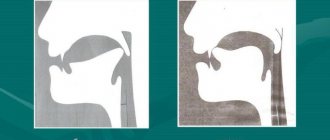Why pick up your baby?
Accustomed to being in a cozy womb-cradle for 9 months, a child becomes afraid of the spaces around him. After all, a newborn is so small compared to the outside world.
Developing inside the woman, the baby constantly heard her heartbeat and felt the warmth of her body. After birth, not yet able to distinguish objects, the little one can easily identify his mother by the smell and biological fluids emanating from her.
Note! The closer the contact, the calmer the baby is - next to his mother he feels protected. Such sensations are especially important for children in the first 3 months of life.
This does not mean that the toddler should be worn from morning to night. But until he adapts to the world around him, they take him in their arms not only for feeding time.
Doctors call the first months “term pregnancy.” The baby still lacks motor skills, imperfect visual function, and a poorly developed thermoregulation system. All this negatively affects adaptation. Being in close proximity to the mother, the baby calms down, the transition to new conditions of development occurs smoothly, without stress.
The skin-to-skin method of communication is especially important for premature babies. With constant contact with the mother, the baby’s temperature stabilizes, blood sugar levels normalize, and metabolism improves. The closer the mother is, the better the physical and mental development of the baby.
Feeling of security
During the first 90 days of life, the baby cries not only because he is hungry or sick - he is afraid of losing contact with his mother. Through communication with her, trust in the world is established. If during this period a woman ignores the baby’s crying and rarely takes him in her arms, the baby develops anxiety. The constant feeling of discomfort later develops into a feeling of uselessness.
Basic rules when carrying a baby
How to teach a child to drink water at different ages
Newborn babies have a weak spine and insufficiently strong ligaments. Therefore, the baby does not yet know how to hold his head. The development of its skeleton and the formation of future posture depend on how the toddler is carried in their arms. This is especially important for girls - the beginnings of a slender figure are laid in infancy.
In order for the vertebral curves, muscle corset, and hip joints to develop organically, the mother must know how to carry the baby correctly. This technique has its own characteristics, they should be followed:
- the child is held so that his arms and legs are grouped and not dangling;
- when laying the baby horizontally, he is supported from all sides;
- in an upright position, the main support is provided to the back so that the load is evenly distributed along the spine;
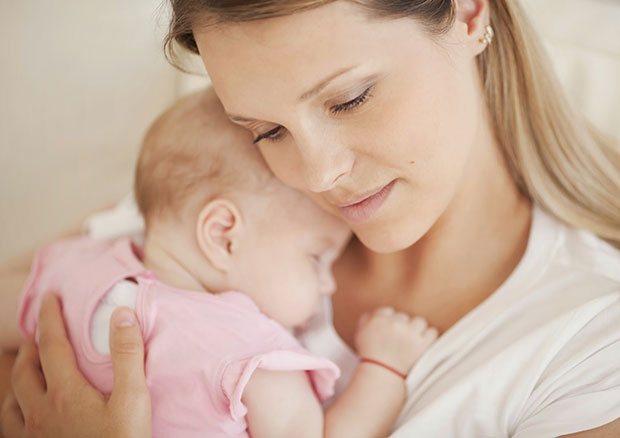
Comfortable position
- Until the baby learns to hold his head, his mother helps him with this.
Note! To avoid disturbances in the development of the vestibular and musculoskeletal system, the baby's carrying technique is selected based on his age.
What not to do
Separately, I would like to “go through” the precautions and outline how not to pick up and hold a child in your arms.
- Do not lift the child by the hands or wrists. The joints of a newborn baby are still very weak.
- You cannot lift the baby without holding the head. The neck muscles are also not yet strong; without support, the head falls back.
- If the baby is already in your arms, make sure that his arms and legs do not hang down.
- In an upright position, you should always ensure that the backrest is supported. The vertical load on the spine is very harmful for a newborn baby, and the consequences may not appear immediately, but only closer to preschool age.
- You need to hold the baby in your arms very carefully, without squeezing him too tightly.
Watch the video: how not to carry a child in your arms. Incorrect grips:
Existing positions for carrying a child
Development of an infant at 4 months of age
There are several positions in which moms and dads carry the little one. Some poses have a functional purpose, others are created for ease of movement.
Basic positions
| Name | Description |
| Main | This position is also called the “cradle”. The mother supports the baby in such a way that his head is comfortably positioned on the elbow, his back along the entire length of the arm. In this case, the child’s legs should not hang down. To make the baby comfortable, the mother presses him to her stomach. In this position, the child is fed, rocked, and newborns are carried in their arms while walking. For convenience, help yourself with your second hand. |
| Column | The baby is kept in an upright position for some time after feeding so that he burps. It is convenient to calm a baby in this position if he bursts into tears. Holding the toddler by the body, press him to the chest so that the head is located on mother’s (father’s) shoulder. While the baby has weak neck muscles, it is necessary to fix the adult’s palm on the back of the baby’s head. |
| One Arm Pose | It is used for a short time if the mother needs to do something, but she cannot leave the baby without attention. In the same position, it is convenient to wash the little one. The baby is placed on a half-bent arm so that the head rests on the bend, and the mother’s fingers hold the baby’s leg just above the ankle. |
| Facing the world | Dads love to practice this pose when walking with their baby. It is also used if you need to help the baby empty the intestines. The baby is pressed with his back to his stomach. The child's legs are raised at 90° relative to the body and held securely. In this case, the adult’s hands are located under the baby’s armpits. |
| Tiger on a branch | Some babies like this position - it makes gas easier to pass and helps get rid of colic. The little one is placed with his tummy on his mother’s arm so that his shoulder is in the crook of his elbow. With her palm, the mother holds the little one between her legs. |
| Armpits | In this position, the baby is moved from place to place, passed from hand to hand, or played with. The child is taken in such a way that the spread of the thumb and index finger of the mother’s palm is located clearly under the baby’s armpits, the remaining fingers close on the back, at the level of the shoulder blades. In this case, the baby's head should lean forward, almost touching the mother's chest. |
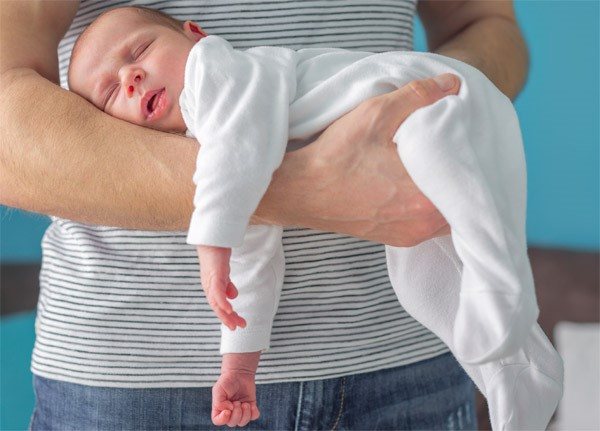
Tiger pose on a branch
The positions described are basic, but parents can interpret them to suit themselves. This will allow you to choose the most comfortable wearing position for both adults and infants.
Poses for the baby during and after feeding
Before feeding, babies can be placed on their tummy or carried in their arms, turned over onto their tummy with their hand. For newborns of the first month, this can be done for no longer than 2 minutes at a time, since they cannot yet hold their head. Babies from 4-6 months can be left in this position for 10 minutes.
While feeding, you can place your baby in your arms or put him on the bed and lie next to him. Dear mothers, if you are breastfeeding, ensure that you are in a position in which you should not bend or overload your arms.
When feeding lying down , the baby is placed along the mother's body, pressed to the chest and stomach, slightly turned onto his side. You need to make sure that the breast does not cover the baby’s nose and that the nipple is properly latched.
To feed the baby while sitting , it is placed on the mother's arm so that the head lies on the bend of the elbow and the back on the forearm. The butt lies on mom’s lap, and the other hand holds the legs. For convenience, you can add a pillow. At the same time, make sure that the head is slightly higher than the baby’s body level, and the whole body lies flat and comfortable:
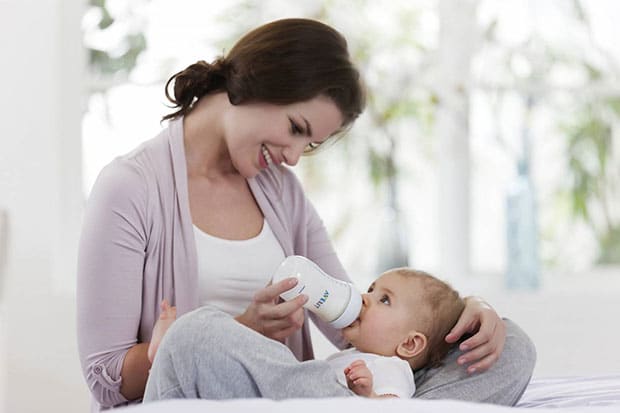
After feeding, the baby needs to be held in a column, that is, vertically, so that the air that entered the stomach with food can easily escape.
To hold a child in a column , you need:
- Gently lift and place the child on your shoulder with his chin;
- Hold the head with one hand and the back and butt with the other.
Babies in the first weeks of life should not be in an upright position for long, as this puts stress on the fragile spine.
Many people are interested in: how long should a newborn be held posture per day? Dear parents, doctors usually answer this by saying that 5-10 minutes after each feeding is quite enough. With the child's support, you can lightly pat the back to help the air escape faster. As soon as the baby burps, you can change position:
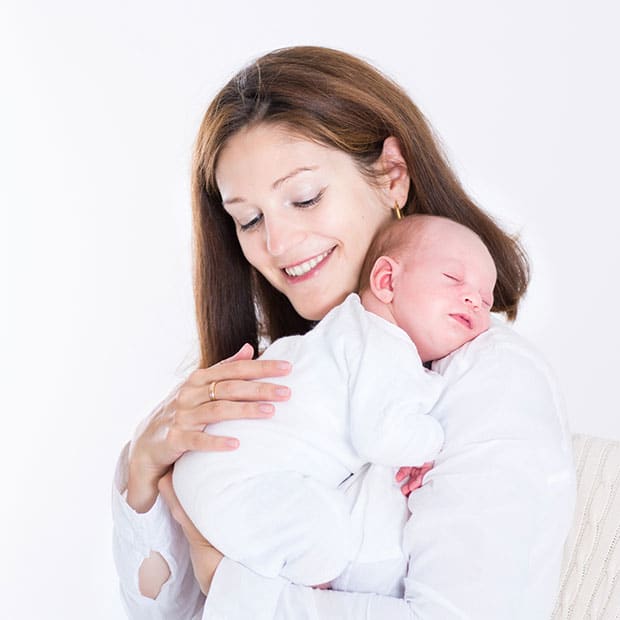
Age-specific baby-wearing technique
How to hold a baby so that he burps and what you can do to help
While the baby weighs little, it is convenient for the mother to carry him in one position. With age and weight gain, in order to hold the little one in your arms, you have to choose other poses. Therefore, it is worth considering the question of how to carry a baby in your arms in each period.
Carrying to term
From the moment of birth and during the first weeks, the baby is provided with the closest contact with his mother. A one-month-old toddler feels protected when there is reliable support for his head. During this period, it is recommended to carry the baby in two arms:
- one - the woman supports the back of the head and neck of the newborn;
- the other is his buttocks.
In this position, the toddler’s torso may be slightly bent at the back, but his face is always facing his mother. For the harmonious and symmetrical development of the baby, the position of the hands must be changed periodically.
2 months
It is already difficult to carry a slightly older baby, so the mother wonders how she can hold a child at 2 months. The newborn will feel comfortable in the “cradle” position. This position is often used to calm a crying two-month-old baby or to take him for a walk without a stroller.
3 months
Mothers do not always think about how to carry a child in their arms at 3 months; they simply continue to use the usual position. But the baby is already showing interest in his surroundings, so the position of the “cradle” can be slightly modified when moving to the third month:
- the back of the baby's head rests on the mother's shoulder;
- her palm squeezes the child's feet;
- handles are fixed with the forearm;
- With her other hand, the woman supports the baby under the buttocks.
In this position, the legs of a three-month-old toddler are spread apart, slightly bent at the hip and knee joints.
Up to six months
You can continue to practice the carrying position described above if it is comfortable for mom and baby. It is better to switch to another position, placing the child “facing the world.”
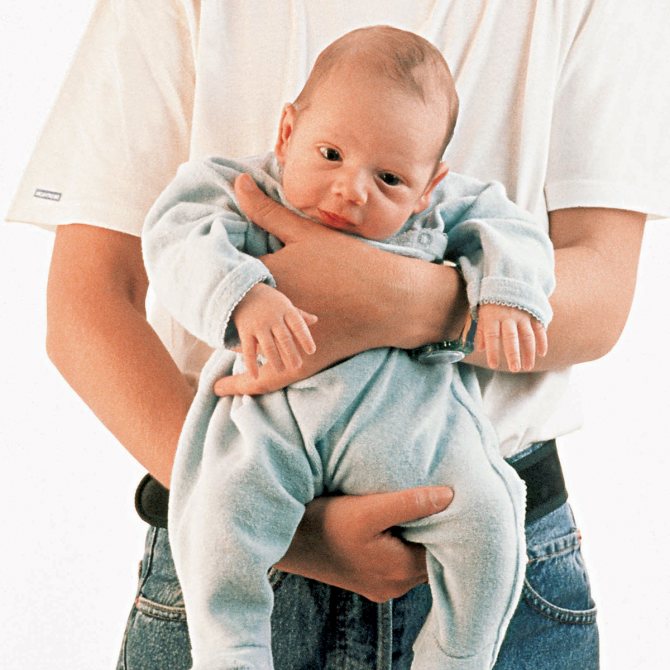
Walking with dad
Grabbing the baby under the chest with your right hand, turn him with his back to you. The left palm is fixed on the toddler’s right thigh so that the legs at the pelvic joints are bent.
When holding the baby, they try to ensure that the baby’s weight does not fall on the arm supporting the pelvis. This will negatively affect the development of the spine.
7 months
From this period on, it is more convenient to hold the child in this position:
- with one hand they take the toddler under the chest;
- the other is passed between the legs, supporting the tummy.
The child's limbs are in a free position, and he actively moves them. It is recommended to practice this position more often - it trains coordination of movements and strengthens muscles, which will allow you to quickly master crawling.
From the 10th month
The baby is already sitting confidently, but has gained enough weight that it is difficult to carry him in his previous positions. At this age, it is more convenient to hold the child in this position:
- the baby’s back rests on the adult’s forearm;
- legs tightly clasping the side;
- the parent supports the child's knee.
The toddler places one hand on the adult’s chest, and freely manipulates the other. For the organic development of the hip joints and spine, the baby should not be constantly carried on one hip.
Wearing positions
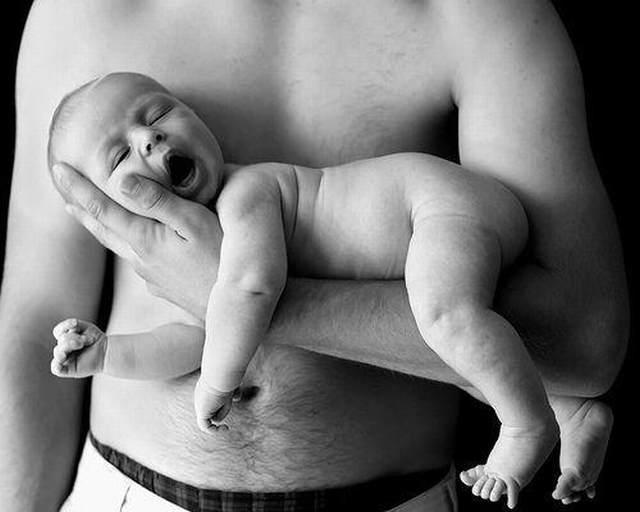
Wearing it in various positions solves not only the issue of transporting your child in space: it is a kind of gymnastics for mother and baby. There are five main poses.
Pose No. 1: classic
On the arm from the elbow to the hand (forearm) face up. This is a classic cradle position, comfortable for carrying and feeding. For a baby from birth to 3 months, the main points of support are the head and back. You can't sit on your butt.
Important! In the first months of life, all actions with the child should be very smooth. A sharp pick-up from the crib, dad’s dashing “son, come here,” combined with tossing and somersaults will frighten the newborn and can lead to injuries.
Pose No. 2: airplane
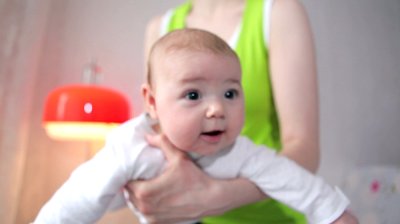
On the forearm, face down, “airplane”: the child lies on the forearm, hands on the mother’s elbow and forearm, stomach on the other hand. The legs are free. The pose is very useful for training the baby’s back muscles, as well as normalizing digestion - a kind of tummy massage, similar in benefits to lying on the stomach. The pose is good from 3 months and older. The baby's head can be turned towards the elbow - this makes it easier to fall asleep, or towards the hand - it is more interesting to play and look at the world around.
Pose No. 3: on the chest
On your chest facing yourself. The mother hugs the baby, placing one hand under the butt through the waist, and the other holding the back and head. This position is calming and soothing.
A possible option is on the chest with a shift to the side, facing you. This is how the baby learns about the world by seeing his mother’s face. Since children study the dangers of the environment based on their mother’s reaction, it is very important for them to see her reaction to a situation or phenomenon.
On the chest facing away from you. Support with one hand across the chest, the other under the butt. Children prefer this position during periods of activity: it is convenient to explore the world around them. Carrying babies under 3 months like this is strictly prohibited. It is recommended to use the pose after 8 months. Until this age, the baby does not understand where his mother has gone and may get scared.
Position #4: front side wearing
Good for babies aged 3 to 6 months. The head is on mom’s shoulder, the neck muscles are being trained. Mom holds the baby's feet. The legs are bent and separated at the knees, which is natural at this age. It is necessary to change hands often - holding on one side for a long time tires mother and baby. The pose develops hip mobility in the hip joints. This position should not be used with heavy children: the mother will lean heavily to the side, causing harm to the spine.
Pose option: worn in front with support of one leg. The child's chest is on the forearm, with the other hand we bend and support the upper leg and tummy. The baby's lower hand lies on the mother's elbow. One side of the baby’s body is fixed, the other is in a mobile state. Useful for babies from 7 months, develops leg muscles, stimulates crawling.
Pose No. 5: on the hip
Worn on the hip. Suitable for children who have learned to sit well, from about 9 months. The baby “sits” on his mother’s hip, wrapping his legs around her, supporting himself independently. The mother supports the baby with her hand, grabbing him under one leg, fixing the back.
To carry your baby at home or while walking or going to the store, use a traditional device for carrying children - a sling scarf. With its help, you can carry your baby in all of the listed positions. With certain skills and habits, a sling scarf is an indispensable assistant for a young mother, allowing her to more evenly distribute the load on the spine of both mother and baby.
Video lesson will help you better understand how to properly carry your baby in your arms
How to properly place a baby on a surface
When picking up a baby, do not make any sudden movements. Everything should happen smoothly and measuredly. It is also important to correctly place the infant on the surface, following the recommendations:
- regardless of the position in which the baby was carried before putting him in the crib, on the sofa, changing table, move to the “cradle” position;
- holding the little one with both hands, bend down as close to the surface as possible and freeze for several minutes in this position;
- lay the baby down and wait for him to calm down;
- only then they gently take one hand out from under it (the one that was holding the legs), then the second one from under the head.
If you plan to move the baby from your arms to the surface to lay him on his tummy, then first turn him over slightly, holding his forearm and shoulder with one hand. The second brush is brought under the armpit from the opposite side.
How to place a child on a horizontal surface?
There is nothing complicated about this, but you should pay attention to a few rules:
- We lift and put the baby down without sudden movements, otherwise you will frighten the baby and instill in him mistrust of his parents. We take the little one smoothly and calmly.
- You can’t lift by the handles; we lift by the shoulder blades and armpits. Another option is to support your head with one hand and hold your butt with the other hand. Raise it so that your head is slightly higher.
- We also put the baby down quietly and smoothly. Moreover, it is advisable to lay it down not on outstretched arms, but bending over, first laying it down, and then moving away.
It is advisable to take the baby in your arms as often as possible.
Young parents often don't know what to do if their newborn cries. Advice: read our article. The daily routine of a newborn in the first month is here. Check your schedule.
Basic mistakes when wearing
To avoid future problems with the spine, the child is carried correctly in infancy. Otherwise, the nerve endings between the vertebrae will be pinched, and the cartilage will be compressed, causing discomfort (sometimes pain) to the baby.
Not all parents think about this, making serious mistakes while carrying a baby:
- at two or three months they begin to sit the baby in a reclining position;
- placing the child with his back to himself, they hold him by the butt, and not under the knees, which puts the baby’s spine under tension;
- they forget to record the close contact of the toddler’s back with the adult’s chest, and the child leans forward;
- placing the baby on your hip, they try to keep him sitting; although in reality the baby should hang on the mother's side;
- holding the baby in an upright position, instead of fixing the hand on the back of the head, the mother places it on the back in the area of the shoulder blades.

Carrying in a column
When choosing a position for carrying a baby in your arms, they proceed first of all from the child’s comfort conditions, then they think about their own comfort. This will allow you to choose the most optimal option without compromising the health of the little one.
If the baby is difficult to carry
When the baby demands constant attention to himself and does not want to slide off his arms, the mother does not have time to do anything around the house. At the same time, the woman gets tired both physically and psychologically. Special devices will help alleviate the situation.
Slings
They were practiced by great-grandmothers when they went out with their babies to work in the fields. Among some tribal peoples, slings are still the main attribute of women with small children. The device is so convenient that civilized Europeans began to use it.
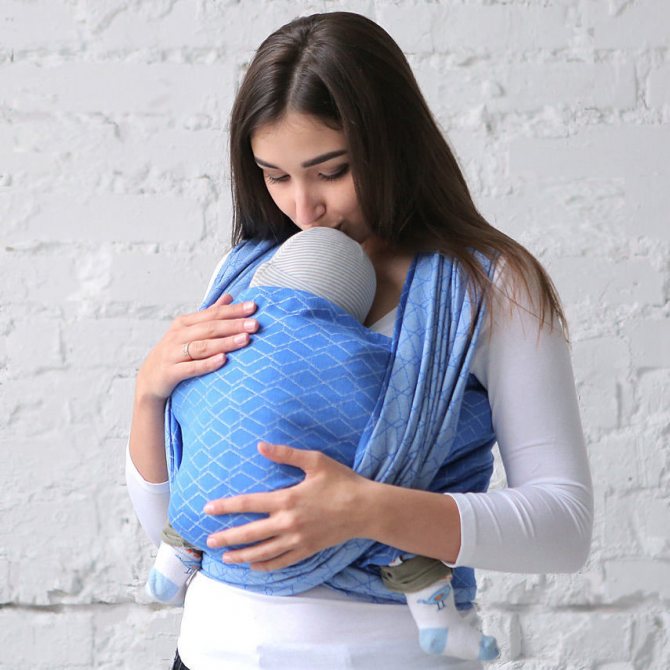
Convenient device
The classic version is a piece of material that reliably supports the back and head of the baby. At the same time, his butt sags slightly, and his legs bent at the knees are spread wide apart. This position will prevent dysplasia from developing and is the most comfortable way to carry your baby.
Other devices
If in a sling a child is always turned to face his mother and can bury his nose in her chest at any moment, then other methods of carrying deprive the little one of this opportunity. In terms of convenience, they are inferior to slings:
- kangaroo does not take into account the physiology of infants and does not provide support to the spinal muscles;
- baby carriers are more ergonomic compared to kangaroos, comfortable for the baby and allow the mother to evenly redistribute the load on areas of the body; but this device can be used no earlier than the baby is six months old;
- hipsit - a seat on a rigid belt, attached to the mother’s hip or waist; it is easy to use, can be quickly put on and taken off, but is suitable for short-term wear - it is bulky and puts pressure on mother’s hips; Designed for babies who can sit independently.
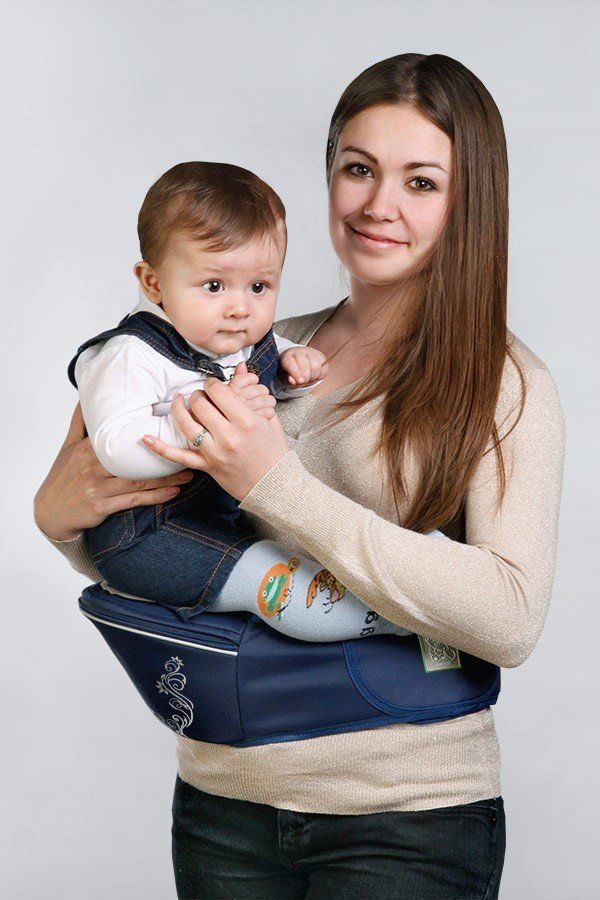
Hipsit in action
Note! Of all the listed devices, slings are the most convenient and safe. They can be used from the first weeks of a baby's life.
Whatever method of carrying the baby is chosen, it must be followed according to all the rules and take into account the developmental characteristics of the child’s body. The child’s health and posture subsequently depend on this.
